On the itinerary it seemed pretty exotic: camping amid ancient ruins and then with monks on a sacred mountain in northern Cambodia. The reality turned out to be, well, different, but perhaps a lot more illuminating.
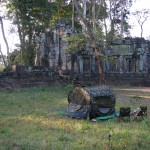
Our first night was at Prasat Thom, one of the most notable ruined religious sites at Koh Ker, an Angkorian capital city from the first millennium. The second night would be within a Buddhist monastery atop Phnom Kulen following a day of hiking from the base. Phnom or Mt. Kulen has long been a sacred site for Cambodians because of its striking 40 kilometer long ridge and a reclining Buddha carved over a thousand years ago directly into a granite peak at the top. Plus, even the king honors the site with regular visits for the spring waters made holy by their flow over two sacred ancient carvings, a section with a thousand lingas and a still visible image of the three hindu gods, all culminating in a splendid waterfall.
So, pretty exotic, but with our handlers there to set up the tent and make sure we were fed and watered, it seemed likely to be a comfortable as well as a peaceful time. Of course, there’s always the issue of waking early, hard ground beneath you and toileting to wrestle with, but that’s camping anywhere.
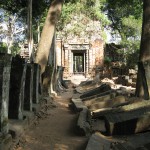
The first site, Prasat Thom, seemed even more evocative than the restored temples in Siem Reap, a worthy site for peaceful camping and meditation. Some pillars of the original building were now toppled at odd angles; some lay on the ground precisely where they once stood, as if some Khmer Samson had pushed over the colonnade and mountings all at once. Gone were the magnificent statuary that we saw a few days later in Phnom Penh. But, at the back of the site, a man-made mountain rose magically from a cow pasture in seven levels, each of which measured about 17 feet high, a mass of sandstone blocks.

The camping turned out to be far from peaceful however, as befits a place welcoming many visitors, for the site was fronted by several family restaurants run by nearby villagers who also stayed here overnight.
First, there was the friendly man of the house who stayed up to drink beer and munch wild boar with our guides. Their laughter got louder and more sustained for an hour or so, as the communing and presumably the jokes improved, but they soon wound down and slept.
Then there were the surprisingly nervous dogs of the place, whom we designated security dogs. Wary of us when we arrived, they seemed to assign one of their number to stay with us near our mock camouflage tent. When someone arrived or passed by motorcycle, they trotted over to check them out. But, several times in the middle of the night, they found some reason to start up a loud wolf-like chorus that seemed to last forever. That in turn would stir the roosters to crow, including one particularly asthmatic bird that seemed to be ridding itself of a smoker’s cough. And those birds reliably began their own chorus at around 4 am, followed within an hour by the villagers’ awakening to do their own coughing, lay out cookery, check out the morning news on the radio, and set out the tourist souvenirs.
Tranquil, this was not. But we gained more than tranquility, since we actually saw more of the daily routines of life than when we stayed in a tribal village.
In addition to sharing some of the typical end of day family conversation, we saw how they kept clean. Every house has a large tub of clean water near the building. Next to the tub is a small bamboo platform to stand on. You take water from the tub to wash hands or brush your teeth, or take a shower. To do that, you fill a scoop and start pouring the cool water all over yourself, then use soap or shampoo to clean, then repeat the scooping to wash yourself off. Now Cambodians are modest people so they’re not naked when doing this, but instead wear an all-purpose sarong/towel, donning clothes deftly afterwards, then laying out the sarong to air dry for the next time. The woman of the house did a complete bath and hair wash with minor deft manipulations of her sarong. We had no sarong, but dived in so to speak and did the same washing in our bathing suits.
We also watched preparations for the next day’s visitors, as two young daughters stayed up late, one chopping lemongrass and other items for at least an hour, lit only by a miner’s light on her forehead, while her eight year old sibling impressively wielded a large chopping knife for her tasks.
A busy evening overall, though, in the silent middle of the night, we glimpsed overhead the boundless sparkle of stars and galaxies before returning to a fitful rest.
While our second evening of camping, at Mt. Kulen, was actually noisier than the first, we found some better sleep, partly due to our tiredness from the first night and partly due to the 11- 12 mile hiking of the day.
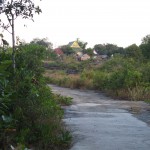
That hike followed the 1500 foot high route up the steeply stepped pilgrim path by which penitents and observant Buddhists have long climbed to a prayer site near the top. On this Sunday, however, the place was more alive with the sounds of children playing noisily at the large pool there than the quiet hum of the prayers just above them. Nor could we proceed quietly on our own as a cadre of village children “guided” us along the trail past the sacred spring waters, while the waterfall area was filled with partying weekend visitors. Nor did we feel particularly contemplative at our lunch stop where the hosts put on a CD of anomalously perky Christmas music. We envied those people who were picnicking more peacefully on little covered platforms along the river.
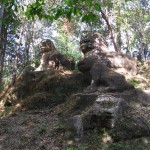
The hike did finish in much more restful fashion as we gradually climbed for an hour to a rarely visited tenth century elephant sculpture carved into the rock alongside two imposing lions. Then we retraced our steps to arrive at the monastery just before dark.
Here again the dogs conspired to break up the night. And a natural chorus kept busy: a swarm of wasps above us buzzed incessantly, whining cicadas sounded off like a generator with ungreased metal parts, and the wind noisily rustled the large leaves overhead sounding just like a downpour.

For a while, just before dawn, all fell silent under the resplendent night. Then the roosters awoke and the mountain top resonated with a half-hour dharma recited by the monks for their morning prayers. Led by a phrase from the elder leader, the small group chanted verse after verse in ancient Pali, a set of unique long phrases each had memorized. Along with the sonorous baritones, a young novice’s soprano piped his mastery of most of the chants.
What we gained in all this was further insight into the manner and rhythms of the monastery. When we arrived, we saw how the monks lived in simple rooms of a plain building within the complex, and bathed in open air stalls, each of which featured a short aluminum tub to fill and douse oneself, as we saw the night before. There was little grand about the rest of the complex, though it was graced with some newly donated patches of silver-painted funerary stupas and a colorful open-air temple in traditional style.
At 6:30pm, we heard them chant their evening prayers right while we set up camp in a treed area nearby. Hopefully not too sacrilegious, we enjoyed a plentiful evening meal forbidden to the monks and drank a few unholy beers as well. It was clear that neither our noise and activity, nor any of the canine or natural disruptions, mattered to them. Before and after the ceremony, the monks peered over at us as curiosities, but when they prayed nothing distracted them from their sacred task.
Perhaps we might have hoped for a more monk-like and peaceful experience than we had in camping. Instead we found an unusual path to understanding more about the people of Cambodia.
(For more pictures from Cambodia, CLICK HERE to see the slideshow at the end of the Cambodia itinerary page.)


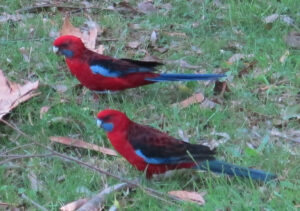
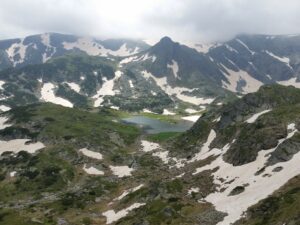
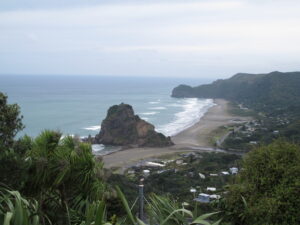
two words (perhaps one?): Earplugs. I never leave home without em
Good point about having earplugs, but we had them and they only helped a bit out there in the “wild”. Still, they are the sleeper’s friend whether you’re in the countryside or in an urban hotel.